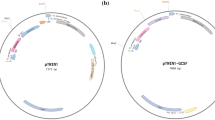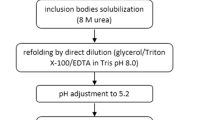Abstract
Enhanced therapeutic importance of recombinant human granulocyte colony stimulating factor (rhG-CSF) has encouraged us to develop a processing method for its high-level expression in E. coli. In this study, we established a high-yielding clone by incorporation of silent mutations at N-terminal region of human G-CSF gene. We studied and optimized various parameters of culture conditions connected with the expression of rhG-CSF. The maximum expression was obtained in a defined medium supplemented with 1% glucose. The gene in pET-3a vector in E. coli BL21 (DE3) PLysS host strain was induced with 2 mM isopropyl β-d-1-thiogalacto pyronoside. The cell growth and productivity was enhanced about 1.6- and 1.5-folds, respectively when inducing the culture at OD600 value of 6 than 2. The protein expression was significantly increased by addition of rifampicin at concentration of 200 μg/ml. The AT content of 51.8% with suitable codon sequences at N-terminal region and the concentration of rifampicin were identified as the key factors with a significant impact on protein expression. The specific productivity of 104 mg/OD/l (68.7% of total cellular protein) of rhG-CSF was obtained toward the end of the study, which is almost 1.5 times higher yield than reported so far in the literature.





Similar content being viewed by others
References
Tamura, M., Hattori, K., Nomura, H., Oheda, M., Kubota, N., Imazeki, I., Ono, M., Ueyama, Y., Nagata, S., & Shirafuji, N. (1987). Induction of neutrophilic granulocytosis in mice by administration of purified human native granulocyte colony stimulating factor (G-CSF). Biochemical and Biophysical Research Communication, 142, 454–460.
Nagata, S. H., Tsuchiya, M., Asano, S., Yamamato, O., Hirata, Y., Kubota, N., Oheda, M., Nomura, H., & Yamazaki, T. (1986). The chromosomal gene structure and two mRNAs for human granulocyte colony stimulating factor. EMBO Journal, 5, 575–581.
Nagata, S. H., & Fukunaga, R. (1991). Granulocyte colony stimulating factor and itsreceptor. Progress in Growth Factor Research, 3, 131–141.
Morstyn, G., Campbell, L., Souza, L. M., Alton, N. K., Keech, J., Green, M., Sheridhan, W., Metcalf, D., & Fox, R. (1988). Effect of granulocyte colony stimulating factor on neutropenia induced by cytotoxic chemotherapy. Lancet, 1, 667–672.
Souza, L. M., Boone, T. C., Gabrilove, J., Lai, P. H., Zsebo, K. M., Murdock, D. C., Chazin, V. R., Bruszewski, J., Lu, H., & Chen, K. K. (1986). Recombinant human granulocyte colony stimulating factor; effects on normal and leukemia myloid cells. Science, 232, 61–65.
Teshima, H., Ishikawa, J., Kitayama, H., Yamagami, T., Hiraoka, A., Nakamura, H., Shibata, H., Masaoka, T., & Takaku, F. (1989). Clinical effects of recombinant human granulocyte colony stimulating factor in leukemia patients: a phase I/II study. Experimental Hematology, 17, 853–858.
Hoglund, M. (1998). Glycosylated and non-glycosylated recombinant hG-CSF, What is the difference? Medical Oncology, 15, 229–233.
Nagata, S., Tsuchiya, M., Asano, S., Kaziro, Y., Yamazaki, T., Yamamoto, O., Hitata, Y., Kubota, N., Oheda, M., Nomura, H., & Ono, M. (1986). Molecular cloning and expression of cDNA for human granulocyte colony stimulating factor. Nature, 319, 415–418.
Komastu, Y., Matsumoto, T., Kuga, T., Nishi, T., Sekine, S., Satio, A., Okabe, M., Morimoto, M., Itoh, S., & Okabe, T. (1987). cloning of granulocyte colony stimulating factor cDNA and its expression in Escherichia coli. Japanese Journal of Cancer Research, 78, 1179–1181.
Weickert, M. J., Doherty, D. H., Best, E. A., & Olins, P. O. (1996). Optimization of heterologous protein production in Escherichia coli. Current Opinion in Biotechnology, 7, 494–499.
Baneyx, F. (1999). Recombinant protein expression in Escherichia coli. Current Opinion in Biotechnology, 10, 411–421.
Hannig, G., & Makrides, S. C. (1998). Strategies for optimizing heterologous protein expression in Escherichia coli. Trends in Biotechnology, 16, 54–60.
Kane, J. F. (1995). Effects of rare codon clusters on high-level expression of heterologous proteins in Escherichia coli. Current Opinion in Biotechnology, 6, 494–500.
Chen, G. T., & Inouye, M. (1994). Role of AGA/AGG codons the rarest codons in global gene expression in Escherichia coli. Genes and Development, 8, 2641–2652.
Hale, R. S., & Thompson, G. (1998). Codon optimization of the gene encoding a domain from the human type 1 neurofibromin protein results in three fold improvement in expression level in Escherichia coli. Protein Expression and Purification, 12, 185–188.
Hu, X., Shi, Q., Yang, T., & Jackowski, G. (1996). Specific replacement of consecutive AGG codons results in high level expression of human cardiac troponin T in Escherichia coli. Protein Expression and Purification, 7, 289–293.
Devlin, P. E., Drummond, R. J., Toy, P., Mark, D. F., Watt, K. W. K., & Devlin, J. J. (1988). Alteration of amino-terminal codons of human granulocyte-colony-stimulating factor increases expression levels and allows efficient processing by methionine aminopeptidase in Escherichia coli. Gene, 65, 13–22.
Shu, Z. H., & Qinong, Y. (1998). Expression of cDNA for rhG-CSF in E. coli and characterization of the protein. Chinese Journal of Cancer Research, 10, 256–259.
Kang, S. H., Na, K. H., Park, J. H., Park, C., Lee, S. Y., & Lee, Y. I. (1995). High-level expression and simple purification of recombinant human granulocyte colony stimulating factor in E. coli. Biotechnology Letter, 17, 687–692.
Fallah, M. J., Akbari, B., Saeedinia, A. R., Karimi, M., vaez, M., Zeinoddini, M., Soleimani, M., & Maghsoudi, M. (2003). Over expression of recombinant human granulocyte colony stimulating factor in E. coli. I J M S, 28, 131–134.
Saeedinia, A., Sadeghizadeh, M., Maghsoudi, N., Akbari, B., Fallah, J., & Karimi, M. (2002). Construction and cloning of humangranulocyte cology stimulating factor (hG-CSF) cDNA. Modarres J M S Spring-Summer, 5, 55–64.
Jacobson, A. (1987). Purification and fractionation of Poly A + RNA. Methods in Enzymology, 152, 254–261.
Weber, K., Pringle, J. R., & Osborn, M. (1972). Measurement of molecular weights by electrophoresis on SDS-acrylamide gel. Methods in Enzymology, 26, 3–27.
Helmut, B., Hildburg, B., & Gross (1987). Improved silver staining of plant proteins, RNA and DNA in polyacrylamide gels. Electrophorisis, 8, 93–99.
Kubo, M., & Imanaka, T. (1989). mRNA secondary structure in an open reading frame reduces translation efficiency in Bacillus subtilis. Journal of Bacteriology, 171, 4080–4082.
Liebhaber, S. A., Cash, F., & Eshleman, S. S. (1992). Translation inhibition by an mRNA coding region secondary structure is determined by its proximity to the AUG initiation codon . Journal of Molecular Biology, 226, 609–621.
Voges, D., Watzele, M., Nemetz, C., Wizemann, S., & Buchberger, B. (2004). Analyzing and enhancing mRNA translational efficiency in an Escherichia coli in vitro expression system. Biochemical and Biophysical Research Communication, 318, 601–614.
Qing, G., Xia, B., & Inoute, M. (2003). Enhancement of translation initiation by AT-rich sequences downstream of the initiation codon in Escherichia coli. Journal of Molecular Microbiology and Biotechnology, 6, 133–144.
Srivastava, P., Bhattacharaya, P., Pandey, G., & Mukarjee, K. J. (2005). Over expression and purification of recombinant human interferon alpha2b in Escherichia coli. Protein Expression and Purification, 41, 313–322.
Studier, F. W. (2005). Protein production by auto induction in high density shaking cultures. Protein Expression and Purificaion, 41, 207–234.
Grossman, T. H., Kawasaki, E. S., et al., (1998). Spontaneous cAMP dependent de repression of gene expression in stationary phase plays a role in recombinant expression instability. Gene, 209, 95–103.
Holms, H. (1996). Flux analysis and control of the central metabolic pathways in Escherichia coli. FEMS Microbial Review, 19, 85–116.
Pan S, & Malcolm, B. A. (2000). Reduced background expression and improved plasmid stability with PET vectors in BL 21 (DE3). Biotechniques, 29, 1234–1238.
Khalilzadeh, R., Shojaosadati, S. A., Bahrami, A., & Maghsoudi, N. (2003). Over expression of recombinant human interferon–gamma in high cell density fermentation of Escherichia coli. Biotechnology Letter, 25, 1989–1992.
Travers, A. A., & Burges, R. R. (1969). Cyclic reuse of RNA polymerase sigma factor. Nature, 222, 537–540.
Kuderova, A., Nanak, E , Truksa, M., & Brzobohaty, B. (1999). Use of Rifampicin in T7 RNA polymerase driven expression of a Plant enzyme: Rifampicin improves yield and assembly. Protein Expression and Purification, 16, 405–409.
Thomas, J. G., & Baneyx, F. (1996). Production of misfolding and induction formation in recombinant Ecsherichia coli cells overexpressing heat shock protein. Journal of Biological Chemistry, 271, 11141–11147.
Hoffmann, F., & Rinas, U. (2004). Role of heat shock protein in the production of recombinant proteins in Escherichia coli. Advances in Biochemical Engineering and Biotecnology, 89, 143–161.
Oh, M. K., & Liao, J. C. (2000). DNA microarray detection of metabolic responces to protein over production in Escherichia coli. Metabolic Engineering, 2, 201–209.
Gill, R., Delisa, M., Valdes, J., & Bentlay, W. (2000). Genomic analysis of high cell density recombinant Escherichia coli fermentation and “cell conducting” for improved recombinant protein yield. Biotechnology and .Bioengineering, 72, 85–95.
Acknowledgements
The authors are highly thankful to the authorities of Natco Pharma Limited, Hyderabad for providing support in all aspects of this work. The technical support from the Analytical Development Division of Natco Research Centre is gratefully acknowledged.
Author information
Authors and Affiliations
Corresponding author
Rights and permissions
About this article
Cite this article
Krishna Rao, D.V., Rao, J.V., Narasu, M.L. et al. Optimization of the AT-content of Codons Immediately Downstream of the Initiation Codon and Evaluation of Culture Conditions for High-level Expression of Recombinant Human G-CSF in Escherichia coli . Mol Biotechnol 38, 221–232 (2008). https://doi.org/10.1007/s12033-007-9018-3
Received:
Accepted:
Published:
Issue Date:
DOI: https://doi.org/10.1007/s12033-007-9018-3




